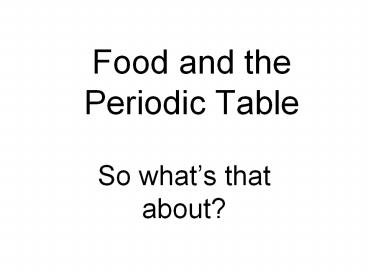Food and the Periodic Table - PowerPoint PPT Presentation
1 / 17
Title:
Food and the Periodic Table
Description:
Food and the Periodic Table So what s that about? Food It does your body good! Cells are the basic unit of life. Cells get into groups to do special functions ... – PowerPoint PPT presentation
Number of Views:56
Avg rating:3.0/5.0
Title: Food and the Periodic Table
1
Food and the Periodic Table
- So whats that about?
2
FoodIt does your body good!
- Cells are the basic
- unit of life.
- Cells get into groups to do special functions
(help the heart, strengthen bones, etc.) - The human body has a hundred trillion
cellsthats a lot!
3
Your body is made up of
4
Bone
- The body has about 206 bones
- Bone is made mostly of protein and calcium and
phosphorus poop - Functions
- Framework for the body
- Protect vital organs
- Store minerals
- Makes the blood
5
Muscles
- The body has more than 600 muscles
- Muscles are made mostly of protein
- Functions
- Helps the body move
- Regulate body temperature
- Helps the systems do their work (lungs, heart,
legs, brain, etc.)
6
Fats
- Its gotten a bad rap lately
- Fat is stored in special cells called adipose
tissue (fat cells) - Functions
- Insulation to protect the body from cold
- Protects vital organs keeps them in place
- But too much can cause health problems!!!
7
The Periodic Table (the key!)
- Chemicals are the make-up of every cell in our
body. - Therefore, in order to build better bodies, we
need to put the chemicals in that the body needs. - SO.
8
The basisa thing of beauty!
9
What does your label have to do with any of this
stuff?
10
A closer look at your label
- What can you link directly to the periodic table?
- What about all those other things on the label?
- Whats the connection to all that other nutrition
information?
11
Carbohydrates
- Also have some subgroups
- Sugars (simple)
- Starch (more complex)
- Dietary fibre (very complex)
12
Carbohydrates
- Made up of sugar units including
- Glucose, Fructose, Lactose, Galactose, Maltose
- Carbon
- Oxygen
- Hydrogen
- See page 75 in Nutrition and Fitness
13
Protein
- Made up of amino acids
- Carbon
- Oxygen
- Hydrogen
- Nitrogen
14
Fats aka Lipids
- Made up of subgroups including
- Saturates
- Mono polyunsaturates,
- Cholesterol
- Carbon
- Oxygen
- Hydrogen
- Sometimes nitrogen and phosphorus
- See page 93 in Nutrition
- and Fitness
15
Vitamins
- Water soluble
- Bs (thiamin, riboflavin, niacin, pantothenic
acid, biotin, B6, B12) - C
- Fat soluble
- A,D, E K
- Carbon
- Hydrogen
- Oxygen
- Some
- Phosphorus
- Nitrogen
- Sulphur
- Cobalt
16
Minerals
- Macro
- Calcium
- Phosphorus
- Magnesium
- Sulphur
- Sodium
- Potassium
- chloride
- Micro
- Iron
- Zinc
- Iodine
- Fluoride
- Selenium
- Chromium
- Copper
- Manganese
- molybdenum
17
Back to what we eat!!!































